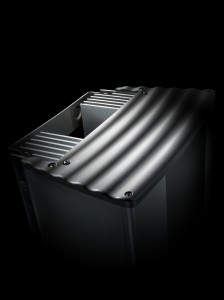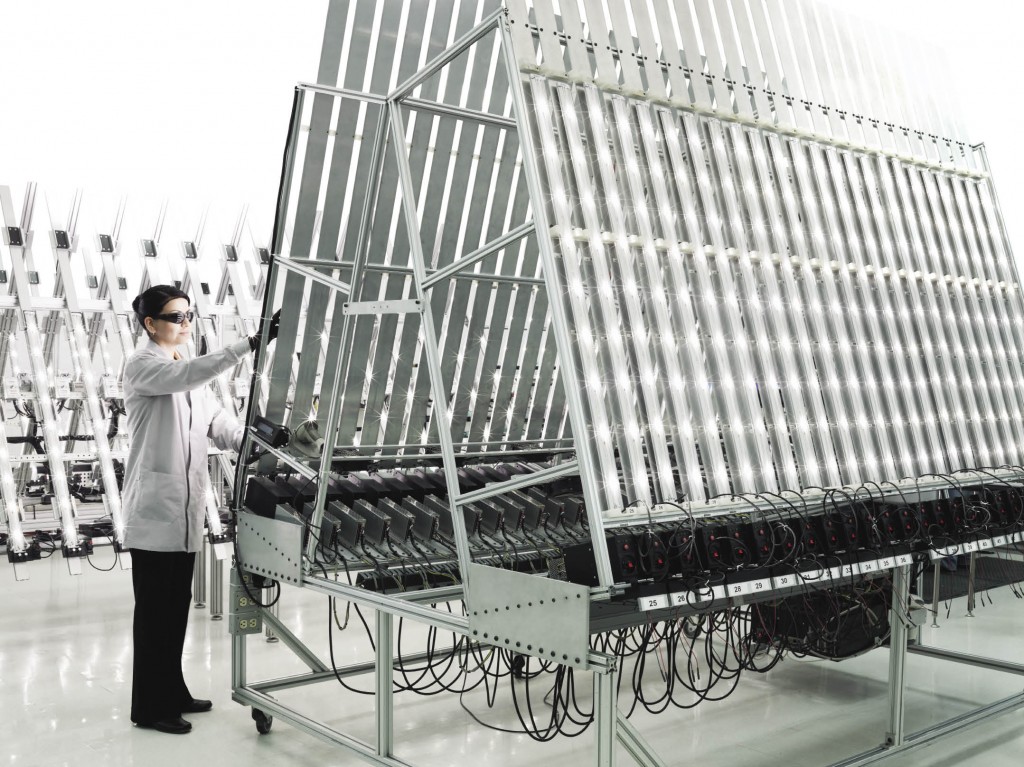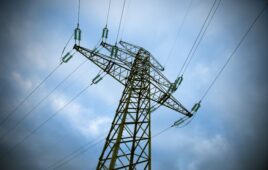With volatile demand for solar energy products across the world, successfully bringing a solar product from concept to reliable volume production is one of the solar industry’s biggest challenges. The drumbeat to make the product cost less by using fewer parts and materials, design it so it assembles in half the time, fabricate and assemble it anywhere and everywhere places pressure in an industry that is faced with potential commoditization.
Going into volume production on a global basis means leveraging the assets and expertise of a manufacturing partner when your company doesn’t have the in-house capability and capacity and resources. Market forces require a new approach and mindset to meet time to market and competitive pressures.
Design is Job 1
A study by Ford Motor Co. showed that although product design non-recurring engineering (NRE) and development comprise only about 5% of the product cost, design can influence the final cost up to 70%, whereas the combination of materials, labor and overhead together only influence the remaining 30%. The most effective way to manage quality and cost is to start with the product’s design.
When you look at the different elements of a solar product’s life cycle, there are many challenges:
• Product design issues such as:
1) Energy collector obstacles with optics alignment and silicon quality;
2) Designing efficiency into Balance of Systems (BOS) — mechanical support structures, inverters, control systems, etc.
• Manufacturability issues such as element proofing and coating (i.e. plating) large support structures;
• Parts fabrication process selection — e.g. cold forging vs. machining of complex high-precision components,sand casting vs. pressure casting, stamping vs. forging, etc.;
• Sourcing and supplier fit — assuming the supplier can handle prototypes well, will they also be able to handle scale and sizing? (i.e. equipment, process);
• Deployment and launch challenges, i.e. documentation in multiple languages, organizing multiple sites, orchestrating material delivery and fulfillment worldwide, completing regulatory requirements (to just name a few); and
• Volume scaling and global production. Of all the elements, design represents the greatest opportunity for cost reduction and quality improvement in each one of these areas.
 The Value Chain
The Value Chain
Solving these dilemmas is the raison d’être of the value chain — the entire team of people who are responsible for ensuring the product gets to market. This includes design engineers, manufacturing engineers, quality engineers, logistics specialists, procurement specialists, test engineering, assemblers, machinists, inspectors, application engineers, sales reps, financial analysts, supply-chain managers, marketing managers — and that’s not even a complete list. Each of them has a role to play in the success of the product, and each can contribute (to a greater or less degree) at various stages to reducing costs, increasing quality and speeding the delivery of the product. The key to success is getting them all involved, right at the start, when the product is in the concept stage.
The product’s design process significantly affects each of the value chain members’ functions. As an example, instead of designing a BOS’s 20-foot structural member which requires hot-dipped galvanization — where only a handful of suppliers have large enough plating tanks that can handle such a size (based on the findings from the manufacturing engineers, quality engineers, procurement specialists and supply-chain managers) — why not design modular structures where many suppliers and plating contractors anywhere can easily perform the task? With the value chain’s involvement in this particular example, significant savings would have been realized in the form of lower costs, quicker turnaround and at higher quality before significant investments in manufacturing lines and materials had been made.
Involving the value chain early and often in the product’s design and development yields extraordinary savings over the product’s life cycle. The cost to correct design errors increases by a factor of 10 at each step of the process. A $1 design error found during concept development could easily reach $1,000 during rapid prototyping, or tens of thousands of dollars during NPI, even reaching hundreds of thousands of dollars during volume production. In addition, each engineering change order, once actual tools and materials are involved, will significantly delay market entry.
Here are the most important factors I recommend for consideration when planning on ramping a product to volume globally:
• Integrate Design for Manufacturability (DFM) and Value Analysis / Value Engineering (VAVE) into the product-development process.
Waiting until after a product’s design is “finalized” before incorporating design for manufacturability (DFM) will often result in discovering it can’t be manufactured at the realistic targeted cost, volume, location or schedule that was planned. To reduce time to market and avoid unnecessary costs and constraints, run DFM/VAVE in parallel with product design. When run in parallel, these processes simplify the design and provide alternative material and manufacturing process choices, thus getting the product to market faster while improving the bottom line.
Each design has its own challenges and opportunities. For example:
• Most mechanical systems, such as BOS for CPVs, can be simplified with minor modifications such as incorporating multiple brackets into main structures, resulting in better material use by incorporating modular designs and benefiting from common tooling and fixturing.
• Large enclosure assemblies can be redesigned so they are fabricated from fewer pieces of metal—resulting in lower material costs and less weight, while also making them less costly to transport. Or designing a CPV module grid that can fold on itself and take up less space during transport and installation.
• Consider modularity and DFMA (design for manufacturing and assembly) principles for simplification such as using standard tooling to reduce cost.
• Perform cost modeling before the prototype phase
Cost modeling goes beyond just parts acquisition and manufacturing and takes into consideration assembly techniques, different supply chain strategies, logistics and transportation paths/strategies.
Cost elements dynamically change as a function of location, materials, transport, and assembly techniques. Access to cost standards is a primary key to accurately modeling the final production unit cost and, therefore, the price.
The value chain is intrinsically involved with all the elements related to costing and has mastered the capability of preserving margins using efficient and cost-effective supply-chain strategies. They have the tools, resources, knowledge and expertise to simulate and validate the cost of the product from concept to volume production.
And given the physical size of many solar products, such as CPV, thin film, or CSP (concentrating solar power – thermal), it is also best to review material availability and logistics early on to avoid inherent costs.
In addition to cost reduction across all elements, product simplifications typically yield even greater savings. Fewer mechanical parts, and consolidated sub-assemblies, will mean lower product cost, more efficient transportation, less weight and less fuel consumption as a function of volume.
• Integrate Design for Reliability (DFR) at the earliest design stages
Since most solar products are exposed to extremely harsh environmental conditions and still expected to operate at peak efficiency at all times, their reliability is paramount.
Building prototypes and physically testing them under the same environmental conditions and usage where they will be installed, is a crucial phase of DFR. The right tools, equipment and experts are needed to conduct those tests and to interpret the results accurately. In most cases, the value chain has either the testing capability in house, or a proven track record of dealing with experts for the specific subject matter.
Including automation in various fabrication processes, such as assembly and optics calibration, also plays a crucial role in delivering consistent product performance in the field. An example would be welding leads instead of soldering to power leads to eliminate soldered-joins failures in the field because of large temperature cycles.
Automation starts at the prototype stage. To take advantage of automation as cost-efficiently as possible means designing the manufacturing process at the earliest stage in product design. Doing so results in a more secure manufacturing process where the equipment is already identified and sourced, the skill-set is readily available and the learning cycle is completed.
Scaling Up to Volume Production
To become viable products in the market, most solar products are destined for large volume manufacturing. Their scalability is inextricably intertwined with their design and strategic supply chain. Specific product requirements, coupled with supply and material constraints for solar products, means that the top global solar industry leaders are running DFM, DFR and cost-modeling processes in parallel with their product design.
Fully using the global capabilities and local support systems of your value chain is the safest way to securely scale up volume production, especially because the solar industry supply chain is complex (solar cells, tracking technology, inverters, control systems, power storage and transmission, BOS). Accordingly, New Product Introduction (NPI) processes must be well-defined to avoid launch and scaling issues such as preventing shortages, mitigating equipment limitations, overcoming geopolitical obstacles, plugging fulfillment gaps — all of which can be minimized when the value chain has been involved from the beginning of the product’s design.
Taking advantage of the value chain’s engineering ecosystem lets the manufacturing roadmap be created early on, so it can be continuously updated and improved before flipping the switch to volume. Consequently, design, engineering, manufacturing, supply chain and logistics problems or issues are ironed out early enough to yield significant product life cycle savings in costs and — scaling to volume becomes relatively seamless. SPW
By: Josh Chien/Sr. Director of New Product Introduction at Sanmina-SCI
Chien is responsible for leading the New Product Introduction (NPI) Advanced Manufacturing solutions on behalf of Sanmina-SCI.








Tell Us What You Think!